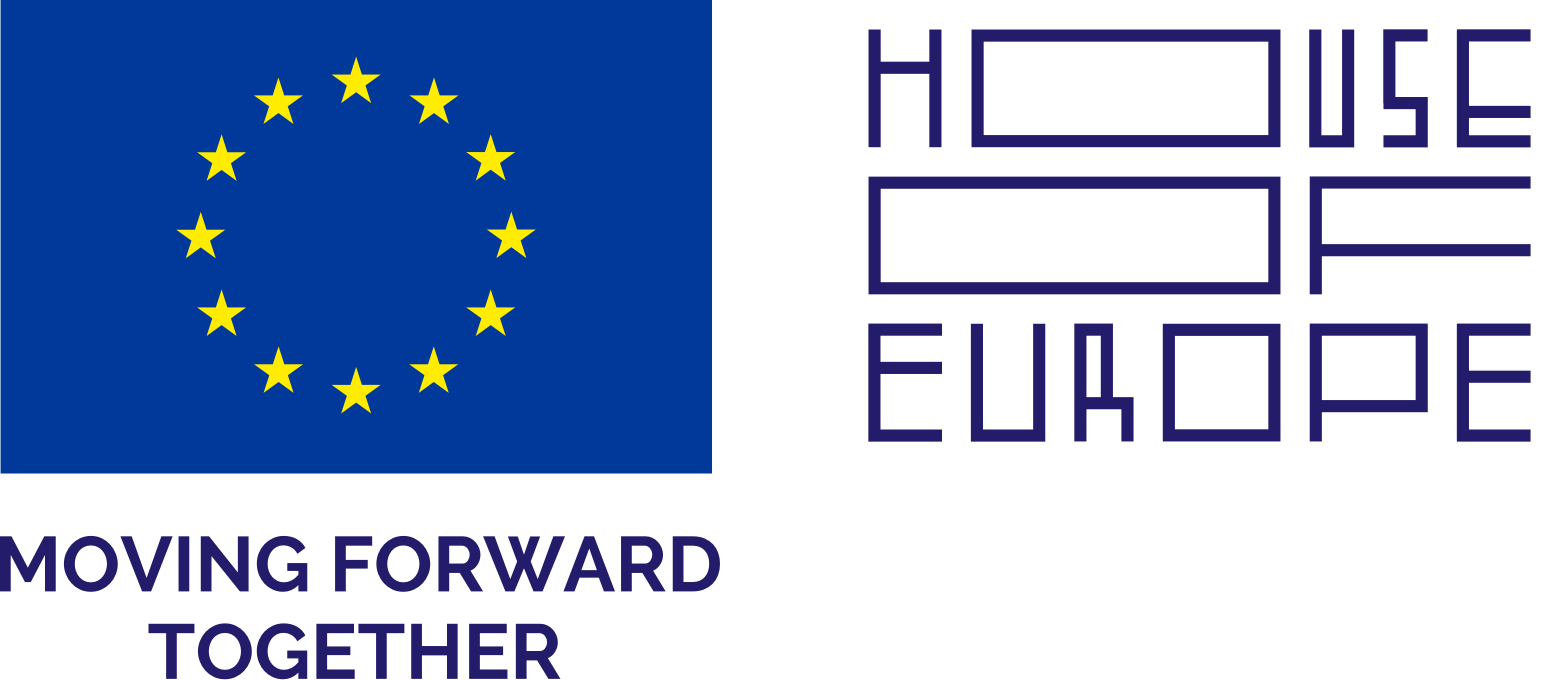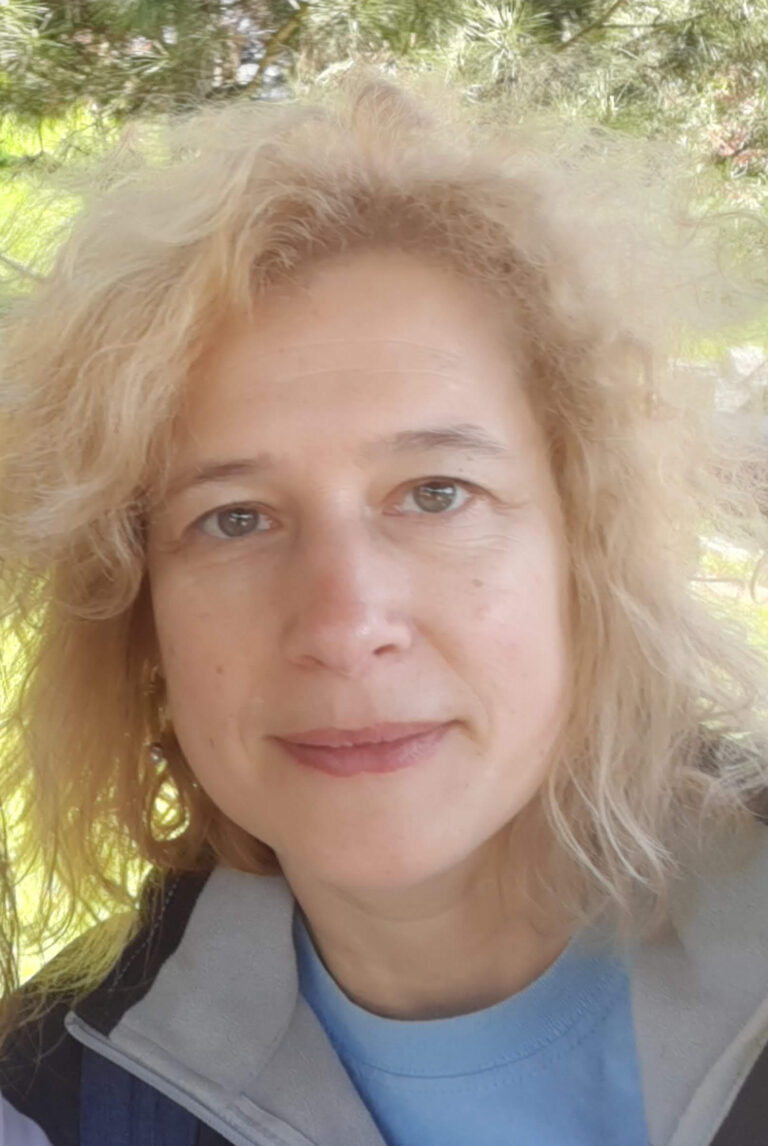

— born in 1972 in Simferopol. In 1999 she graduated from the National Academy of Visual Arts and Architecture with a degree in painting. She worked in the field of easel and monumental paintings, digital and moving images art, installation and animation. In the 1990s she collaborated with Ivan Tsiupka and Solomiia Savchuk. One of the central subject-matters of her work is the boundaries of art. She currently resides and works in Kyiv.
I was born in Simferopol (Crimea)1 in 1972 to the family of a carpenter – an interior designer and a printing master. My childhood was filled with the scent of printing ink, sounds of a printing press and wood chips, painted interiors, flowers and portrayals. A large garden, an old house and piles of books and magazines did their job. Imagination was running wild. Everything around was like a painting. This helped me sense my potential.
In 1993 I got admitted to Kyiv Art Institute (now – NAOMA). There I met the Paris Commune2 squat artists. Oleksandr Hnylytskyi, Oleh Holosii, Kyrylo Protsenko and others were my role models. These were the people who were doing something on the intersection of painting, sculpture, film and design. At the time it seemed indeed that there were no boundaries. Everything around was art. This lured me and empowered me for the creation of something new. I looked ahead. I started studying computer technology and reinterpreting topics that fascinated me through them34.
Multimedia art provided an excellent opportunity to reinterpret and imagine new projects with the usage of new technology which stimulated me enormously56. Street-art, acrylic and other materials’ manipulations, mixture of technologies and plots in paintings kept being of interest to me. Nowadays, when I work on paintings, I use various accessories to achieve non-conventional textures.
Time has passed. The current political, economic and covid-related situations in Ukraine do not contribute to the emotional stability. This also affects artists. Now my projects take place within the frame of my newly gained experiences – one of being a mother, the other one bordering a war. Modern education does not cultivate children to be thirsty for freedom and honesty, creative thinking and pursuit of knowledge. Children react emotionally: they ponder how they can fight against Volodymyr Putin, how to overcome the economic and political crisis in Ukraine. They highly miss their grandparents who live in the Crimea, as they have not seen each other for 8 years. The family relations were severely cut short by the annexation and the war. This is another sensitive topic of our community. The war runs like a thick red thread through the heart and twists the feelings. The children are growing up with the realization that the world has changed, and the war has arrived here to stay. For many – for almost their entire life. I assist my children to step out unharmed from that difficult period of their life, and defeat the challenges of adolescence so they come victorious out of it. Art exhibitions and projects, movie screenings, walks and travels help to overcome the hurdles of the emotional turmoil.
Everything around is art, but now this is the art of manipulation over consciousness. A new step that could be used in favor of the future. Now I am interested in the topic of how consciousness can be manipulated, how people unknowingly perform the actions programmed by the enemy. In the future I see my art as the one that – with the help of modern digital technologies – provides the co-existence of an artist and a spectator, so the latter can make adjustments to the artist’s work.
The final version of the statement was edited in collaboration with Kateryna Iakovenko (2022).
1Image: Natalia Golibroda-Boyko, Cabriolet, 1996, canvas, oil. Courtesy of the artist.2 “Paris Commune” was the artists’ squat established in 1990 at Paris Commune street which lasted until 1994. After Ukraine's independence had been declared, the street regained its name of Mykhailivska. However, the artists continued to call both the street and the squat by the name Paris Commune honouring the revolutionary government of Paris. Therefore, the name of the street – Parkomuna (short after Paris Commune) became a symbol of an entire phenomenon in contemporary Ukrainian art which emerged in a turbulent era of revolutionary political, economic, social and esthetic changes. See: Parkomuna. Place. Community. Phenomenon., K: Publish Pro, 2018, p. 208.
3Image: Natalia Golibroda-Boyko, Bloody Love, 2001, canvas, oil, fluorescent paint. Courtesy of the artist.
4Image: Natalia Golibroda-Boyko (in collaboration with Solomiia Savchuk and Ivan Tsiupka), Bloody Mary. 2000, video. Courtesy of the artist.
5Image: Natalia Golibroda-Boyko (in collaboration with Solomiia Savchuk), Clothing collection as part of the KIMAF festival. Courtesy of the artist.
6Image: Natalia Golibroda-Boyko (in collaboration with Solomiia Savchuk and Yevhen Boyko), Postcards, 2003, video. Courtesy of the artist.

— народилася у 1972 році в Сімферополі. У 1999 році закінчила Національну академію образотворчого мистецтва та архітектури у Києві за фахом живопис. Працювала у галузі станкового та монументального живопису, цифрового мистецтва та мистецтва рухомого зображення, інсталяції та анімації. У 1990-ті роки співпрацювала з художниками Іваном Цюпкою та Соломією Савчук. Однією з центральних тем мистецької практики є кордони мистецтва. Нині живе та працює в Києві.
Я народилась у Криму (1972 р., Симферополь)1 в родині червонодеревеця — дизайнера інтерьерів і майстра типографії. Дитинство наповнювали запахи типографскої фарби, звуків друкарського верстату та стружек дерева, мальованих інтер’єрів, квитів та живопису. Великий сад, старенький будинок і багато книжок та журналів зробили свою справу. Уява розбурхувалась. Все навколо було живописом. Це допомогло мені відчути мої можливості.
У 1993 році я вступила до Київського художнього інституту (нині — НАОМА). Там познайомилась з художниками сквоту Паризька Комуна2. Олександр Гнилицкий, Олег Голосій, Кирило Проценко та інші були для мене взірцем для прикладу. Це були люди, які робили щось на межі: живопису, скульптури, кіно і дизайну. Тоді дійсно здавалось, що немає меж. Все навколо — було мистецтво. Це мене приваблювало та давало сил роботи щось нове. Я дивилась уперед. Почала вивчати комп’ютерні технології та через них почала осмисляти теми, що мене хвилювали34.
Мультімедійне мистецтво давало дивовижну можливість обдумувати та уявляти нові проєкти, залучати технології і мене це надзвичайно приваблювало56. Стріт-арт, маніпуляції з акрилом та іншими матеріалами, мікс технологій та сюжетів у живописі продовжували також мене цікавіти. Нині, коли я працюю над картинами, використовую різні приладдя, добиваючись нестандартних фактур.
Минув час. Сучасна політична, економічна та коронавірусна ситуація в Україні — все це не сприяє емоційній стабільності. Це також позначається й на художниках. Нині нові проєкти відбуваються з набуттям нового досвіду та сенсу — материнства та війни. Сучасна освіта не виховує жагу до свободи та чесності у дітей, нестандартного мислення та жагу до знань. Діти емоційно реагують: вони розмірковують як можна подолати Володимира Путіна, як можна вийти з економічної та політичної кризи в Україні. Вони дуже сумують за бабусею та дідусем, що мешкають у Криму, адже не бачили їх протягом 8 років. Родинні стосунки грубо розірвала анексія та війна. І це окрема болюча тема нашого оточення. Війна червоною грубою ниткою йде через серце та скручує почуття. Діти зростають, розуміючі, що світ змінився, і війна — це надовго. Для багатьох — майже все їхнє життя. Я допомагаю своїм дітям вийти неушкодженими з складної сторінки їх життя та здолати підлітковий вік і вийти з нього з перемогою. А виставки та мистецькі проекти, перегляди кіно, прогулянки та подорожі допомагають подолати перешкоди емоційних криз.
Все навколо — мистецтво, але тепер вже мистецтво маніпулювання свідомістю. Новий крок, який можна було б використати на користь майбутнього. Зараз мене цікавить тема, як відбувається маніпуляція свідомістю, як люди неусвідомлюючи виконують завдання ворога. Своє мистецтво у майбутньому я бачу таким, де за допомогою використанням сучасних цифрових технологій співіснують митець та глядач, коли глядач може вносити корективи в роботу митця.
Текст написано у співпраці з кураторкою Катериною Яковленко (2022).
1Зображення: Наталія Голіброда-Бойкоа, Кабріолет, 1996, Полотно, олія. Надано художницею.2«Паризька комуна» — сквот, утворений 1990 року в Києві на вулиці Паризької Комуни, який проіснував до 1994 року. Після проголошення незалежності вулиці повернули назву Михайлівська, однак митці далі називали і вулицю, і сквот на честь революцій- ного уряду Парижа. Так назва вулиці — Паркомуна — закріпилася за цілим явищем у сучасному українському мистецтві, яке виникло в бурхливу добу революційних політичних, економічних, соціальних, естетичних змін. Більше інформації тут: Паркомуна. Місце. Спільнота. Явище. — К. : Publish Pro, 2018. — 208 c.
3Зображення: Наталія Голіброда-Бойко, Кривава Любов, 2001. Полотно, олія, флуоресцентна фарба. Надано художницею.
4Зображення: Наталія Голіброда-Бойко (у співпраці з Соломією Савчук та Іваном Цюпкою), BloodyMary, 2000, Відео. Надано художницею.
5Зображення: Наталія Голіброда-Бойко (співпраці з Соломією Савчук), Колекція одягу, у рамках фестивалю KIMAF. Надано художницею.
6Зображення: Наталія Голіброда-Бойко (у співпраці з Соломією Савчук та Євгенієм Бойко), Postcards, 2003, Відео. Надано художницею.
